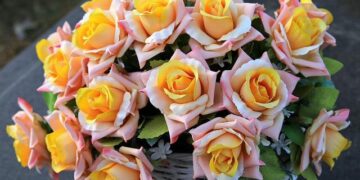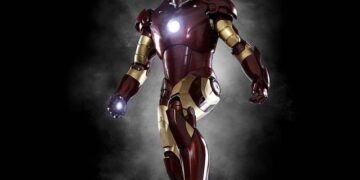THERE ARE BONES EVERYWHERE. Black- and purple-painted models of the horn-faced carnivore Ceratosaurus nasicornis lie arranged by anatomical element in boxes. The cranium of a crocodile-like creature called a phytosaur rests on a worktable. Skeletons of dinosaurs, prehistoric mammals, and other wonders are stacked floor to ceiling in a storeroom. Past it, a Utahraptor ostrommaysi stands midkick, and the massive skull of the three-horned dinosaur Torosaurus waits to be fitted on a body. An artist grinds away at the head of the massive armored fish Dunkleosteus, sanding down its seams.
None of the bones scattered in plain view have been excavated from the ground. They’re resin likenesses that lead many a visitor to wonder aloud, “Are those fakes?” when exploring halls of strange and posed prehistoric skeletons. The answer is usually more complicated than viewers realize—and this busy fossil reconstruction studio in Fruita, Colorado, illustrates that perfectly.
Most people think of museums as hallowed strongholds of authentic dinosaur specimens. Each towering Tyrannosaurus or stupendous sauropod embodies life, death, extinction, survival, and, thanks to Hollywood, the enduring quest of sunburned explorers searching distant deserts. A replica doesn’t deliver that same gut punch of wonder. But that has more to do with our own misconceptions than it does with scientific reality.
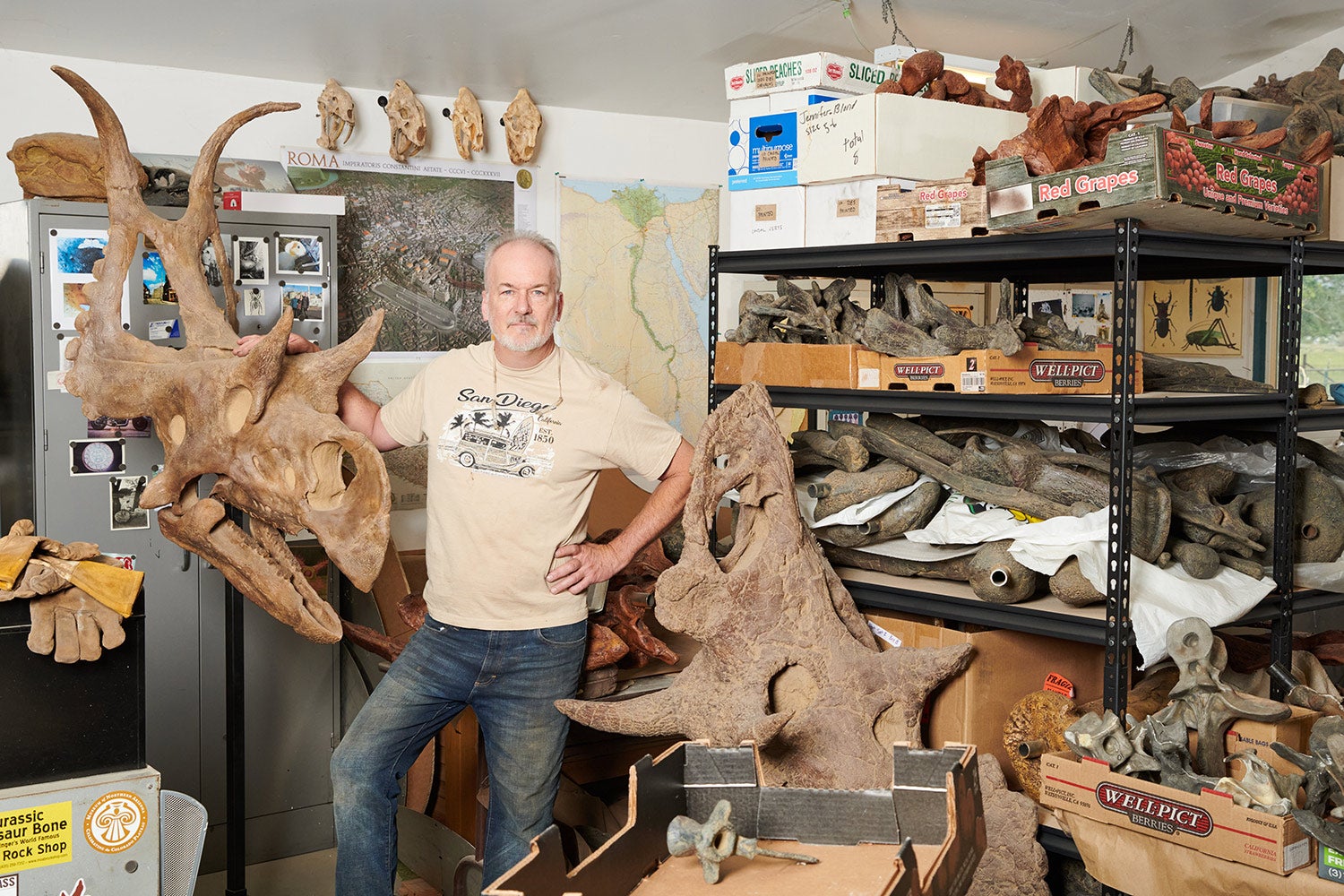 Robert Gaston has focused his craft on paleontology replicas and mounts, including the Diabloceratops seen at left, for almost 30 years. Theo Stroomer for Popular Science
Robert Gaston has focused his craft on paleontology replicas and mounts, including the Diabloceratops seen at left, for almost 30 years. Theo Stroomer for Popular Science
Consider Sue the T. rex, arguably the most famous fossil dinosaur in the world. Standing in its own exhibit in Chicago’s Field Museum, Sue represents at least 80 percent of a full skeleton, making it the most complete specimen ever found of a “tyrant lizard king.” But paleontologists had to fill in the missing pieces with casts of other T. rex specimens they dug up. Sue’s real skull sits in a separate case on the floor, making it look as if the fossil was somehow in a car wreck. The piece is crushed and distorted from about 67 million years of sitting under layers of heavy sandstone. The pristine, grinning head seen on display is a scientifically informed artist’s impression of what the living animal looked like.
Fossil curators often stress the difference between casts and the originals, emphasizing the importance of making copies for display. The Field Museum, Australia’s Museums Victoria, and England’s Oxford University Museum of Natural History all try to get ahead of the “Is it real?” question on their websites. In 2018, London’s Natural History Museum sent its iconic cast of Diplodocus, “Dippy,” on tour, leading some commenters to surmise with shock that the renowned dinosaur had always been a fraud. “Let’s face it,” one Huffington Post commenter sneered, “Dippy isn’t even a dinosaur. She’s a fake.” And it’s not just Dippy—another take from a paleontology educator on reconstructed dinosaurs conceded that “even the best fossil casts are going to lack a certain something that the original fossils have,” though the article failed to dig into what that je ne sais quoi might be. Kids seem to be especially hung up on whether a bone was once part of a real animal or not. In a 2018 study in the International Journal of Science Education, Part B, one child told surveyors that dinosaur casts were “not as special” as original fossils “’cause, eh, you just know that it’s…a piece of plastic or something.’”
That same kid would probably find most genuine skeletons a letdown. Paleontologists occasionally uncover a dinosaur from volcanic ash and other sediments with every bone preserved perfectly in place, but most fossil animals are unearthed incomplete or damaged. If excavators simply freed them from their encasing rock and put them on display, museum patrons would be left scratching their heads over jumbles of weathered, flattened, and broken bones.
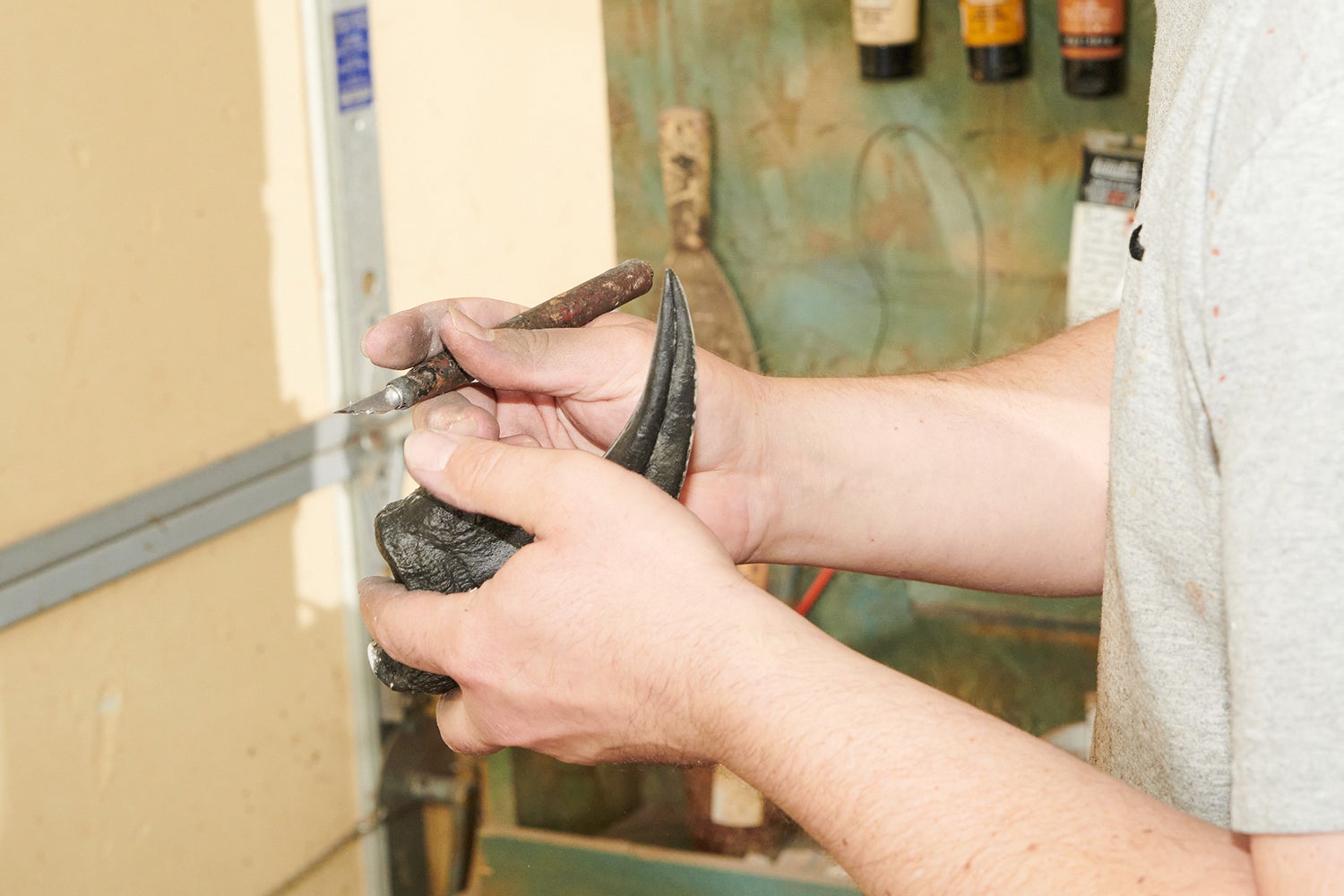 After replicas are molded, seam chasing is one of the early steps in removing excess material to make them look more convincing. Theo Stroomer for Popular Science
After replicas are molded, seam chasing is one of the early steps in removing excess material to make them look more convincing. Theo Stroomer for Popular Science
Casts and replicas bring flawed skeletons closer to what they looked like in real life. So they’re just as important to paleontologists as to they are the public. Reconstruction expert Rob Gaston notes that most of the specimens he receives at his workshop, which he opened 27 years ago with his partner Jennifer Schellenbach, would not be presentable without artistic intervention. The scraps are a far cry from the majestic creatures so many museum visitors hope to see. Liberating fossils from rock is only the first step in bringing a long-extinct animal back to something resembling life.
“Really, the process is twofold,” the artist says as the team at Gaston Design bustles around the maze of tables and cabinets. “The first thing we do is obtain pieces from the museum. Those are usually incomplete, broken, distorted.” It’s like receiving a hand-me-down puzzle with only half the pieces in the box—many of them in sorry shape.
The process doesn’t end with casting and correcting the original material. Whether a dinosaur is standing stock-still or running with jaws agape towards visitors, each reconstruction needs a metal armature that sits inside like a second skeleton. What’s more, the mounts have to be sanded down to remove seams, painted to look like the original rock, and assembled into their full forms before they leave the shop. The result is always something you can envision wrapped in muscle, scaly skin, and feathers.
 Next, the molded bones are scraped, painted with spray paint, and then given a separate “dirt” wash for an aged appearance. Theo Stroomer for Popular Science
Next, the molded bones are scraped, painted with spray paint, and then given a separate “dirt” wash for an aged appearance. Theo Stroomer for Popular Science
THE SCIENTIFIC COMMUNITY hasn’t always had artists like Gaston on hand to fix and fit together those jumbled puzzle pieces. The way paleontologists reconstructed fossil skeletons through much of the 20th century is a perfect example of how even real bones can warp reality. In the bright halls of the American Museum of Natural History in New York City, for example, the iconic Triceratops that’s been tilting its horns at visitors since 1923 is a composite of several different individuals of roughly the same size. Likewise, most bones found in the Ice Age asphalt seeps of Los Angeles’ La Brea Tar Pits turn up jumbled. The chocolate-colored skeletons standing in the site’s museum have been pieced together from parts that don’t always fit. If a skeleton is reconstructed from the bones of several animals that lived in different geographic localities, and perhaps even disparate slices of time, should it count as real?
Attempts to reconstruct what paleontologists uncover from Earth’s geologic record are about as old as the field itself. English paleontologist Richard Owen once mused that plaster copies of fossils might stoke wonder in museum visitors. In 1868, the English artist Benjamin Waterhouse Hawkins worked with Edward Drinker Cope and Philadelphia naturalist Joseph Leidy to create a complete reconstruction of Hadrosaurus foulkii, a herbivorous dinosaur that had been uncovered in the marl pits of southern New Jersey. The real bones were fragile and represented only a portion of the animal’s body, so the team made casts of what they had and sculpted the rest, creating the one and only mounted nonavian dinosaur at the time. The skeleton was a huge hit, perhaps inspiring the next generation of paleontologists to create additional reconstructions.
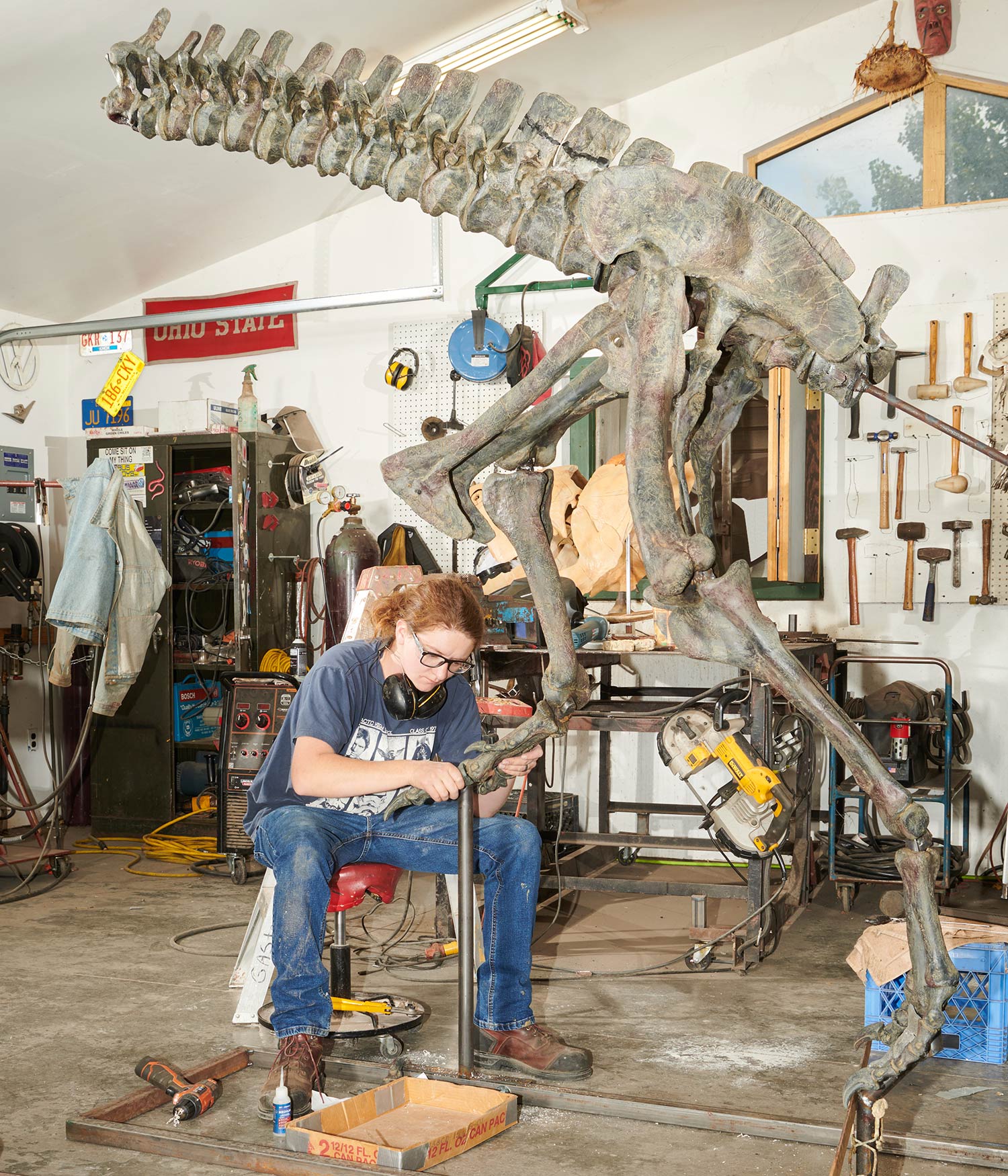 Lindsay Goro assembles a Ceratosaurus model at Gaston Designs. The original skeleton was found right in Fruita. Theo Stroomer for Popular Science
Lindsay Goro assembles a Ceratosaurus model at Gaston Designs. The original skeleton was found right in Fruita. Theo Stroomer for Popular Science
The popularity of more finished-looking fossils generated new questions—and problems—for museums. Creating and assembling casts was a laborious process, and the impression that visitors craved original bones led some institutions to put remains back together with materials like Bondo, an irreversible filler used on automotive and home projects, and to drill through specimens so they could be slotted onto permanent armatures. In time, paleontologists began to favor casts as replacements or complements, even as some in the scientific community saw reconstructions as second-rate.
“I think calling them ‘fakes’ or regarding them as inauthentic doesn’t appreciate how much preparation, construction, and modeling goes into making real fossils into objects that are usable for scientific research or display,” says Chris Manias, a paleontology historian at King’s College London. Instead, casts and reconstructions exist along a continuum, he notes, filling in the gaps on mounts when needed, or standing in for missing fossils entirely.
Manias also disagrees that these thoughtful imitations reduce the wonder inspired by prehistoric creatures. “Casts and reproductions have always remained highly important,” he says, a fact underscored by recent exhibits on a long-necked herbivore called Patagotitan mayorum at several large museums in the US and England. This dinosaur, made of casts from multiple incomplete skeletons, stretches to more than 100 feet long, making it among the largest prehistoric reptiles described by paleontologists. At such stupendous size, awe erases any quibbles about authenticity.
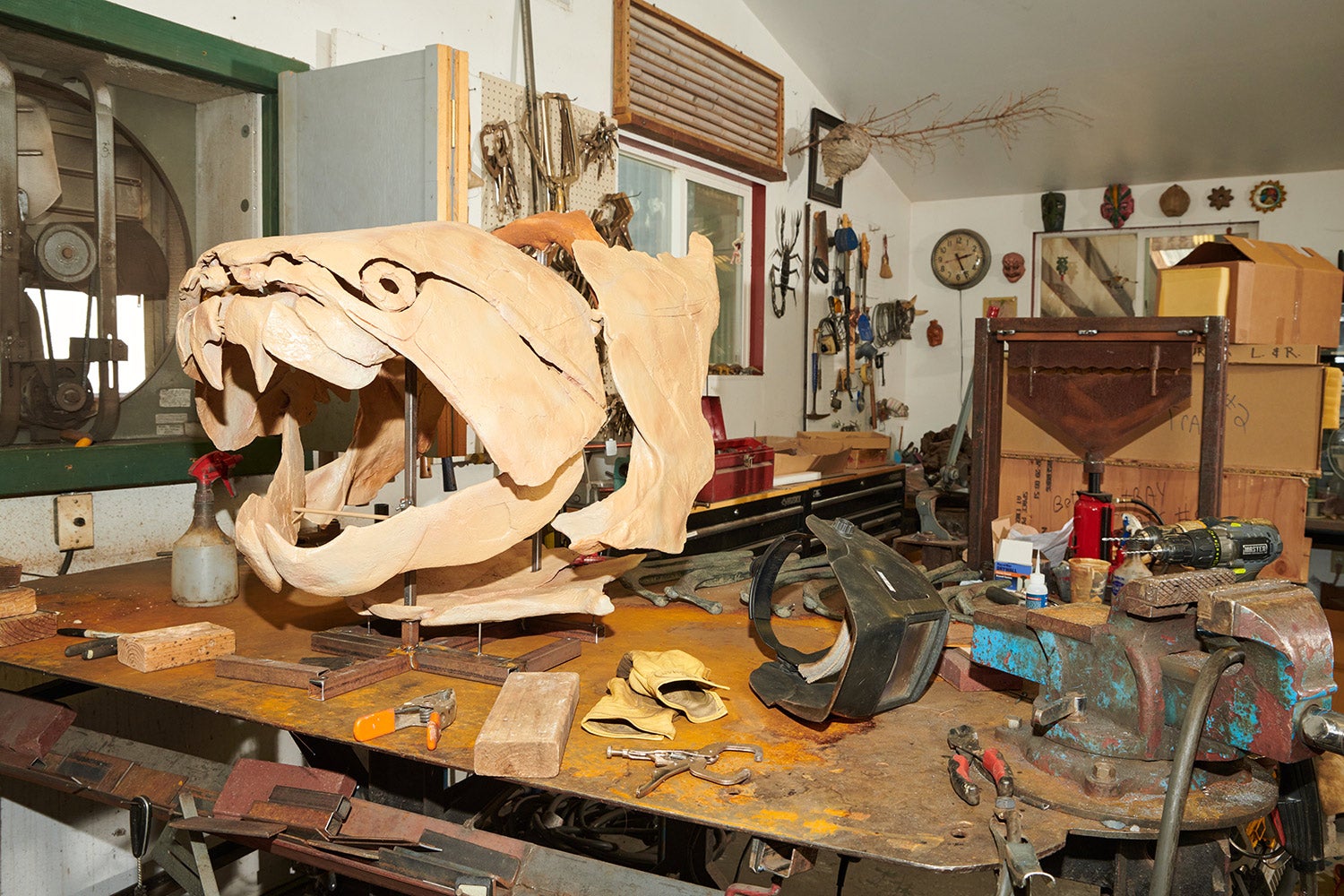 The enormous fish Dunkleosteus lived during the Late Devonian period. You can see its overlapping armored plates in this replica. Theo Stroomer for Popular Science
The enormous fish Dunkleosteus lived during the Late Devonian period. You can see its overlapping armored plates in this replica. Theo Stroomer for Popular Science
AT THE FRUITA STUDIO, Gaston and his crew of artists excel at blending fact and speculation. While Gaston has done some repair work on original fossils, particularly for commercial dealers, he spends most of his time visualizing what fossils looked like when they were still fresh and unscathed, filling in missing skeletal parts to create exhibit-worthy animals for universities and museums.
Everything starts at the casting station, which sits just a few steps inside the workshop door. Copying specimens can be a precarious process given the fragility of most fossil bone. The key is silicone. Placed within a cushioning cradle—with special armatures made for skulls or other large pieces—the fossil is doused in a cloudy, slimelike liquid polymer that is then left to cure. Gaston and his colleagues peel the soft shell away once it’s dry, creating a mold. “Your piece comes out, hopefully without damage,” Gaston says, or at least nothing that can’t be easily repaired. Chips and cracks aren’t unusual. Such a risk might surprise members of the public, but specimens face similar threats at every stage from excavation to display. Experts often break fossils in the field, the lab, and museums. Scientists and preparation specialists have devised all sorts of adhesives and strategies to extend the afterlife of ancient bone, including an entire line of fossil-ready superglues called PaleoBond.
Gaston estimates that most of the skeletons he works on require between 100 and 150 distinct molds, which are stored in an on-site warehouse. The resin casts created from those molds are just the beginning of the reconstruction process. The phytosaur skull sitting on Gaston’s workbench is part of one such project: a beautifully complete cranium of a crocodile-like reptile with sharp teeth about as big around as a human thumb, discovered by paleontologists from the St. George Dinosaur Discovery Site museum. Sometime after the animal’s death about 220 million years ago, something smashed the skull. “As you can see, it’s really, really distorted on one side,” Gaston notes, “so while this is a nice, fairly complete skull, it’s going to need extensive work.” He created a replica from the phytosaur’s mold that he can cut apart, sculpt, and otherwise fix to look like natural, symmetrical bone and not a Triassic pancake.
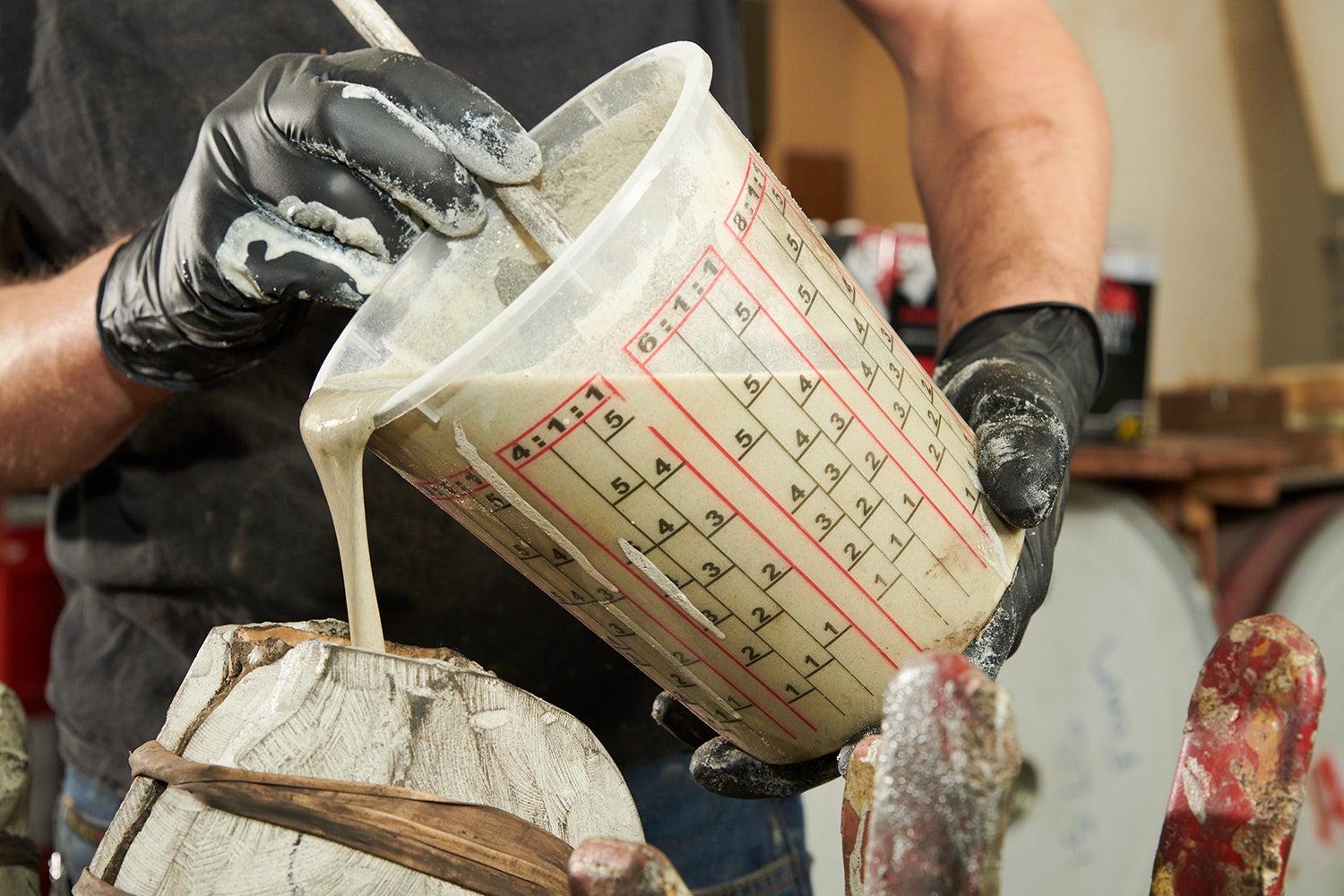 A staff member pours a fossil mold using a polyurethane resin combined with filler material. Theo Stroomer for Popular Science
A staff member pours a fossil mold using a polyurethane resin combined with filler material. Theo Stroomer for Popular Science
Restoring an animal that lived thousands, millions, or tens of millions of years ago is a huge challenge. There are usually no fresh skeletons to compare the reconstructions to for accuracy. Unless paleontologists find a complete, undistorted head, it can be challenging to tell a species’ actual proportions—how far the back of the skull flared out, or the exact position of the nasal openings. The large Torosaurus lying on the workshop floor, for instance, came from a young creature whose bones had not yet fully fused. The skull was in fragments when Gaston began working on it, a three-dimensional puzzle put together according to the anatomy of more mature horned dinosaur specimens. Closely related species can have the same individual bones in their skulls, but with slight variations, and can provide a basic guide to what should fit where. The goal, Gaston says, is to do as little as possible and not over-sculpt such reconstructions. A touch of asymmetry in an otherwise beautiful fossil is better than perfection, which can look unnatural.
At every step of his weekslong process, Gaston keeps museum visitors in mind. “The conundrum you get in is you want to present a cast as close as it can be of what was found, but if it’s a public display piece, you want it to be anatomically something [people] can understand and relate to,” he says. It’s a difficult balancing act, trying to fairly represent the animal while still retaining the texture, color, and overall shape of the fossil. “It’s kind of like refinishing an antique, where you might fix broken parts but you don’t strip the finish off and rebuild,” Gaston explains.
 Elisa Uribe de Gaston works on detailing a replica Bison latifrons skull, the largest bovid ever to live in North America. Theo Stroomer for Popular Science
Elisa Uribe de Gaston works on detailing a replica Bison latifrons skull, the largest bovid ever to live in North America. Theo Stroomer for Popular Science
Still, the inference and guesswork involved is often invisible to the public—and even to artists who base their illustrations on fossil reconstructions. While working on a relatively new dinosaur from Utah, Nasutoceratops titusi, Gaston had to contend with the fact that the dinosaur’s skull was crushed and the horns were bent down, almost like a longhorn cattle’s. He decided against cutting the cast apart and rearranging the horns, leaving them relatively flat instead of angled up. Some decisions have more to do with design or reconstruction capabilities than anatomical certainty. But artistic recreations of Nasutoceratops have perpetuated the image and even exaggerated it, like a game of telephone stretching back millions of years.
Sometimes renderings can be corrected when new evidence turns up. Take Apatosaurus, which sported a deep and boxy head with spoonlike teeth until paleontologists unveiled the real thing in 1978: a wedge-shaped skull with short, pencillike teeth. In these cases, regular dinosaur nerds might think paleontologists are simply making things up. The cachet of authenticity creates a great deal of tension in planning what to present to the public.
“The main argument you hear is ‘The public doesn’t want to see casts, they want to see real things,’” Gaston says. The primary counterpoint is that reconstructing and mounting original fossils can damage the bones in the process. But, Gaston also notes, most of the time the original fossils aren’t even fit to display. “Seventy to 75 percent of the material I deal with may be almost a complete skeleton, but it’s all so badly distorted or mashed that it’s not mountable.” Casting—both for reconstruction and for repairs—allows dinosaur and other paleontological exhibits to better show what was once inside living creatures.
A FEW OF GASTON’S recreations sit in Dinosaur Journey across town. Without casts, “there would be a lot more labels, a lot more signage trying to translate the fossil record,” says Julia McHugh, a curator at the museum. It would require a lot more patience from visitors, perhaps more than they would be willing to give, to explain the identity and orientation of original fossils. Instead, McHugh and other curators have often favored placing the original fossils next to reconstructions. “Then you can say, OK this is what the fossil looks like coming out of the ground; this is what the fossil would look like in life,” she explains.
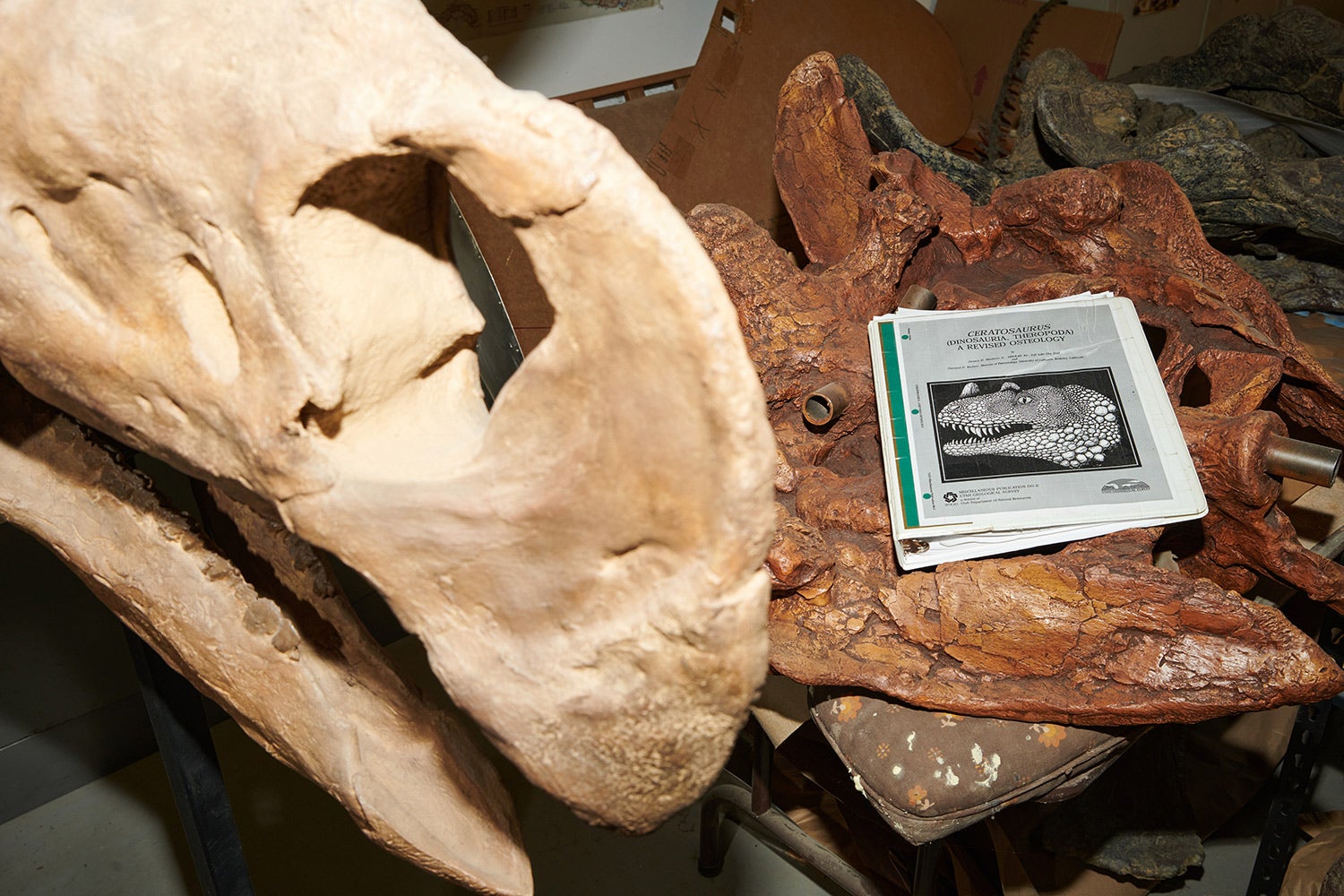 The artists use a paleontological guide to the osteology of Ceratosaurus to reassemble the fossil. Theo Stroomer for Popular Science
The artists use a paleontological guide to the osteology of Ceratosaurus to reassemble the fossil. Theo Stroomer for Popular Science
Over time, paleontologists have gotten better at collecting, constructing, and displaying natural specimens. Some of the grand skeletons in the Smithsonian National Museum of Natural History’s recently renovated Deep Time exhibit are made from original bone. But such undertakings have their own constraints. “It’s expensive; it takes a lot of time; it’s very heavy; and those things do not move,” McHugh says. That means a fossil skeleton of Diplodocus or Tyrannosaurus will have to stand in one spot for years, if not decades, rather than being part of a more modular museum that can change as the science does. A cast, she notes, can come apart in minutes—an advantage that facilities rely on to update their displays or even put on traveling exhibits.
Downstairs from McHugh’s office at Dinosaur Journey, a Ceratosaurus the length of a large SUV stands posed like a cat about to jump on a windowsill. It’s the finished version of the cast in Gaston’s shop. The Jurassic carnivore’s back legs are flexed, and its long tail makes a sinuous S. Its resin jaws remain half open to let the exhibit lights gleam off dozens of recreated teeth. The replica was created using bits of fossil, resting in a nearby glass case, that were picked apart by looters in the nearby Fruita Paleo Area before paleontologists got to them. Its original skull was also flattened, with both sides of the upper jaw wrenched out of alignment. Casts of other Ceratosaurus bones helped fill in the missing parts. The limb bones and vertebrae of the reconstruction obscure the steel that now gives the animal its postmortem form.
 Occasionally, Gaston Designs will do life sculpting, imagining the skin and other features of prehistoric creatures, like this fictitious dinosaur. Theo Stroomer for Popular Science
Occasionally, Gaston Designs will do life sculpting, imagining the skin and other features of prehistoric creatures, like this fictitious dinosaur. Theo Stroomer for Popular Science
But what matters is that the beast looks alive. The sweep of the reptile’s tail almost begs for visitors to envision the muscles, tendons, blood vessels, and other soft parts that must have draped around that skeleton when its kind wandered fern-covered flood plains. Somehow the human-made materials feel closer to the living animal than the degraded remnants of its ancient biomolecules.
The dichotomy between real and fake crumples when we encounter creatures that can be revived only through our imaginations. A paleontologist can certainly work from a collection of bones chipped out of the rock and come up with physical features and measurements, but such data often feels unsatisfying on its own. When those pieces mesh with our best guesses about missing bones, we can start to infer how big the animal was, how it might have acted, and what the Earth was like when we were nothing more than a distant possibility. These casts and reconstructions bring our dreams and nightmares from the Age of the Dinosaurs closer to existence. The dinosaurs we love to gaze at, with their mighty jaws and claws, don’t come to us straight from the rock, but truly come to life in a workshop off a rural Colorado road.
Read more PopSci+ stories.
>>> Read full article>>>
Copyright for syndicated content belongs to the linked Source : Popular Science – https://www.popsci.com/science/dinosaur-fossil-replicas/


